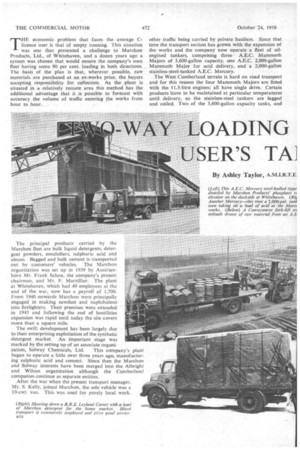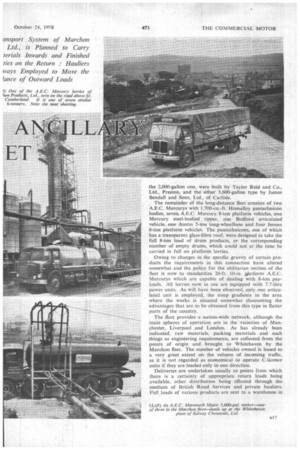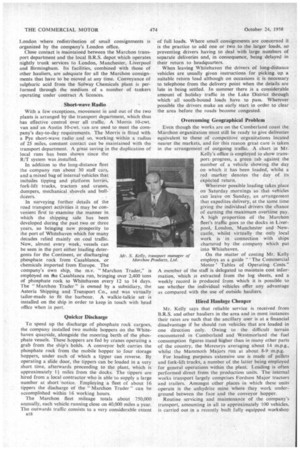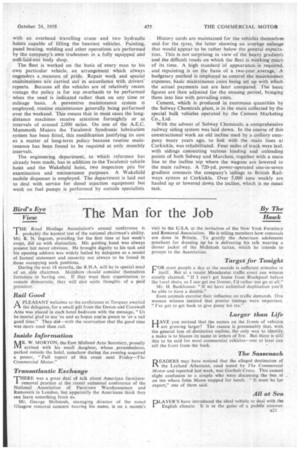LOADING USER'S TA]
Page 50

Page 51

Page 52

Page 55

If you've noticed an error in this article please click here to report it so we can fix it.
By Ashley Taylor, A.M.I.R.T.E. THE economic problem that faces the average Clicence user is that of empty running. This situation was one that presented a challenge to Marchon Products, Ltd., of Whitehaven, and a dozen years ago a system was chosen that would ensure the company's own fleet having some 90 per cent. loading in both directions The basis of the plan is that,. wherever possible, raw materials are purchased at an ex-works price, the buyers accepting responsibility for collection. As the plant is situated in a relatively remote .area, this method has the additional advantage that it is .possible to forecast with accuracy the volume of traffic entering the works from hour to hour. :
. . .
The principal products carried by the Marchon fleet are bulk liquid detergents, detergent powders, emulsifiers, sulphuric acid and olcum. Bagged and bulk cement is transported out by customers' vehicles. The Marchon organization was set up in 1939 by Austrianborn Mr. Frank Schott, the company's present chairman, and Mr. E. Marzillier. The plant at Whitehaven, which had 40 employees at the end of the war, now has a payroll of 1,700. From 1940 onwards Marchon were principally engaged in -making sawdust and naphthalene into firelighters. Their premises were extended in 1943 and following the end of hostilities expansion was rapid until today the site covers more than a square mile.
The swift development has been largely due to their enterprising exploitation of the synthetic detergent market. An important stage was marked by the setting up of an associate organi zation, Solway Chemicals, Ltd. This company's plant began to operate a little over three years ago, manufacturing sulphuric acid and cement. Since then the Marchon and Solway interests haVe been merged into the Albright and Wilson organization although the Cumberland companies continue as separate entities.
After the war when the present transport manager, Mr. S. Kelly, joined Marchon, the sole vehicle was a 10-cwt. van. This was used for purely local work. other traffic being carried by private hauliers. Since that time the transport section has grown with the expansion of the works and the company now operate a fleet of oilengined tankers, comprising three A.E.C. Mammoth Majors of 3,600-gallon capacity, one A.E.C. 2,000-gallon . Mammoth Major for acid delivery, and a 2,000-gallon stainless-steel-tanked A.E.C. Mercury.
The West, Cumberland terrain is hard on road transport and for this reason the four Mammoth Majors are fitted with the 11_3-litre engines; all have single drive. Certain products have to be maintained at particular temperatures until delivery, so the stainless-steel tankers are lagged and coiled. Two of the 3,600-gallon capacity tanks, and
the 2,000-gallon one, were built by Taylor Reid and Co., Ltd., Preston, and the other 3,600-gallon type by James Benda11 and Sons, Ltd., of Carlisle.
The remainder of the long-distance fleet consists of two A.EC. Mercurys With 1,700-cu.-ft. Homalloy pantechnicon bodies, seven A.E.C. Mercury 8-ton platform vehicles, one Mercury steel-bodied tipper, one Bedford articulated vehicle, one Austin. 5-ton long-wheelbase and four Jensen 6-ton platform vehicles. The pantechnicons, one of which has a transparent glass-fibre roof, were designed to take the full 8-ton load of drum products, or the corresponding number of empty drums, which could not at the time be carried in full on platform lorries.
Owing to changes in the specific gravity of certain products the requirements in this connection have altered somewhat and the policy for the utilitarian section of the fleet is now to standardize 20-ft, 10-in. platform A.E.C. .Mercurys which are capable of dealing with 8-ton payloads. All lorries now in use are equipped with 7.7-litre power units. As will have been observed, only one articulated unit is employed, the steep gradients in the area where the works is situated somewhat discounting the adVantages that are to be obtained from this type in flatter parts of the .country.
The fleet provides a nation-wide network, although the main spheres of operation are in the vicinities of Manchester, Liverpool and London. As has already been indicated, raw materials, packing materials and such things as engineering requirements, are collected from the points of origin and brought to Whiteha.ven by the Marchon fleet. The number of vehicles owned is based to a very great extent on the volume of incoming traffic, as it is not regarded as economical to operate C-licence units if they are loaded only in one direction.
Deliveries are undertaken usually to points from which there is a certainty of appropriate return loads being available, other distribution being effected through the medium of British Road Services and private hauliers. Full loads of various products are sent to a warehouse in London where redistribution of small consignments is organized by the company's London office.
Close contact is maintained between the Marchon transport department and the local B.R.S. depot which operates nightly trunk services to London, Manchester, Liverpool and Birmingham. Its facilities, combined with those of other hauliers, are adequate for all the Marchon consignments that have to be moved at any time. Conveyance of sulphuric acid from the Solway Chemicals plant is per formed through the medium of a number of -tankers operating under contract A licences.
Short-wave Radio
With a few exceptions, movement in and out of the two plants is arranged by the transport department, which thus has effective control over all traffic. A Morris 10-cwt. van and art Austin 10-cwt. van are used to meet the company's day-to-day requirements. The Morris is fitted with a Pye short-wave radio and so, 'working within a radius of 25 miles, constant contact can be maintained with the transport department. A great saving in the duplication of local runs has been shown since the 13../T system was installed.
In addition to the long-distance fleet the company run about 30 staff cars,
and a mixed bag of internal vehicles that includes tipping and platform lorries, fork-lift trucks, tractors and cranes, dumpers, mechanical shovels and bull-. dozers.
In surveying further details of the road transport activities it may be convenient first to examine the manner in which the shipping side has been developed during the past two or three years, so bringing new prosperity to the port of Whitehaven which for many decades relied mainly on coal traffic. Now, almost every week, vessels can be seen in the port either loading detergents for the Continent, or discharging phosphate rock from Casablanca, or chemicals imported from Europe. The company's own ship, the m.v. "Marchon Trader," is employed on the Casablanca run, bringing over 2,400 tons of phosphate rock to Whitehaven every 12 to 14 days. The "Marchon Trader" is owned by a subsidiary, the Astoria Shipping and Transport Co., and was virtually tailor-made to fit the harbour. A walkie-talkie set • is installed on the ship in order to keep in touch with h,ead office when in port.
Quicker Discharge To speed up the discharge of phosphate rock cargoes, the company installed two mobile hoppers on the Whitehaven quayside, alongside the mooring berth of the phosphate vessels. These hoppers are fed by cranes operating a grab from the ship's holds. A conveyor belt carries the phosphate rock from the mobile hopper to four storage hoppers, under each of which a tipper can reverse. By operating a slide door, the tippers can be loaded in a very short time, afterwards proceeding to the plant, which is approximately l miles from the docks. The tippers are hired from a local contractor who is able to supply a large number at short 'notice. Employing a fleet of about 16 tippers the discharge of the "Marchon Trader" can he accomplished within 16 working hours.
The Marchon fleet mileage totals about 750,000 annually, each vehicle running dose on 40,000 miles a year. The outwards traffic consists to a very considerable extent 1318 of full loads. Where small consignments are concerned it is the practice to add one or two to the larger loads, so preventing drivers having to deal with large numbers of separate deliveries and, in consequence, being delayed in their return to headquarters.
When leaving Whitehaven the drivers of long-distance vehicles are usually given instructions for picking. up a suitable return load although on occasions it is necessary to telephone from the delivery point when the details are late in being settled. In summer there is a considerable amount of holiday traffic in the Lake District through which • all south-bound loads have to pass. Wherever possible the drivers make an early start in order to clear the area before the roads become congested.
Overcoming Geographical Problem Even though the works are on the Cumberland coast the Marchon organization must still be ready to give deliveries equivalent to those of competitive organizations located nearer the markets, and for this reason great care is taken in the arrangement. of outgoing traffic. A chart in Mr. Kelly's office is employed to show transport progress, a green tab against the number of a vehicle showing the day on which it has been loaded, whilst a red marker denotes the day of its expected return.
Wherever possible loading takes place on Saturday mornings so that vehicles can leave on Sunday, an arrangement that expedites delivery, at the same time giving the individual drivers the chance of earning the maximum overtime pay. A high proportion of the Marchon fleet's traffic goes to the docks in Liverpool, London, Manchester and Newcastle, whilst virtually the only local work is " in connection with ships chartered by the company which put into Whitehaven.
On the matter of costing Mr. Kelly employs as a guide The Commercial Motor' Tables of Operating Costs." A member of the staff is delegated to maintain cost information, which is extracted from the log sheets, and a weekly record is produced from which it is possible to see whether the individual vehicles offer any advantage as compared with the use of outside hauliers.
Hired Haulage Cheaper Mr. Kelly says that reliable service is received from B.R.S. and other hauliers in the area and in most instances their rates are such that the ancillary user is at a financial disadvantage if he should run vehicles that are loaded in one direction only. Owing to the difficult terrain encountered in Cumberland and Westmorland the fuel consumption figures stand higher than in many other parts of the country, the Mercurys averaging about 14 m.p.g., whilst the Mammoth Majors run at about 8-9 m.p.g.
For loading purposes extensive use is made of pallets and fork-lift trucks, a number of the latter being employed for general operations within the plant. Loading is often performed direct from the production units. The internal works transport largely comprises Fordson Major tractors and trailers. Amongst other places in which these units operate is the anhydrite mine where they work underground between the face and the conveyor hopper.
Routine servicing and maintenance of the company's transport, amounting in all to approximately 100 vehicles, is carried out in a recently built fully equipped workshop with an overhead travelling crane and two hydraulic hoists capable of lifting the heaviest vehicles., Painting, panel beating, welding and other operations are performed by the company's own tradesmen in a fully equipped and well-laid-out body shop.
The fleet is worked on the basis of every man to his own particular vehicle, an arrangement which always engenders a measure, of pride. Repair work and special examinations are Carried out in accordance with drivers' reports. Because all the vehicles are of relatively recent vintage the policy is for top overhauls to be performed when the need is indicated rather than on any time or mileage basis. A preventive maintenance system is employed, routine maintenance generally lacing performed over the weekend. This means that in most cases the longdistance machines receive attention fortnightly or at intervals of around 2,000 miles. On one of the A.E.C. Mammoth Majors the Tecalemit Syndronic lubrication system has been fitted, this modification justifying its cost as a matter of long-term policy because routine maintenance has been found to be required at only monthly intervals.
The engineering department, to which reference has already been made, has in addition to the Tecalernit vehicle hoist and the Wakefield hoist, two inspection pits for examination and maintenance purposes. A Wakefield mobile dispenser is employed. The department is laid out to deal with service for diesel injection equipment but work on fuel pumps is performed by outside specialists.
History cards are maintained for the vehicles themselves and .for the tyres, the latter showing an average .mileage that would appear to be rather below the general expeCtation. This is not surprising in view of the heavy gradients and the difficult roads on which the fleet is working .much of its time. A high standard of appearance:, is required, . and repainting is on the basis of a two-year .average. A budgetary .method is employed to control the maintenance_ expenses, basic maintenance costs being set up withWhich. the actual payments out are later compared. The basic figures are then adjusted for the ensuing period, bridging them into line with. prevailing costs.
Cement, which is produced irs enormous quantities by the Solway Chemicals plant, is in the main collected by the special bulk vehicles operated by the Cement Marketing Co., Ltd.
With the advent of Solway Chemicals, a comprehensive railway siding system was laid down. In the course of this constructional work an old incline used by a colliery company Many years ago, to link with the main lines at Corkickle, was rehabilitated. Four miles of track were laid, with sidings connecting various loading and unloading points of bOth Solway and Marchon, together with a main line to the incline top where the wagons are lowered to the main railway. A 720-yd. power-operated one-in-seven gradient connects the company's Sidings to British Railways system at Corkickle. Over 5,000 tons weekly are hauled up or towered down the incline, which is no mean task.




































































































